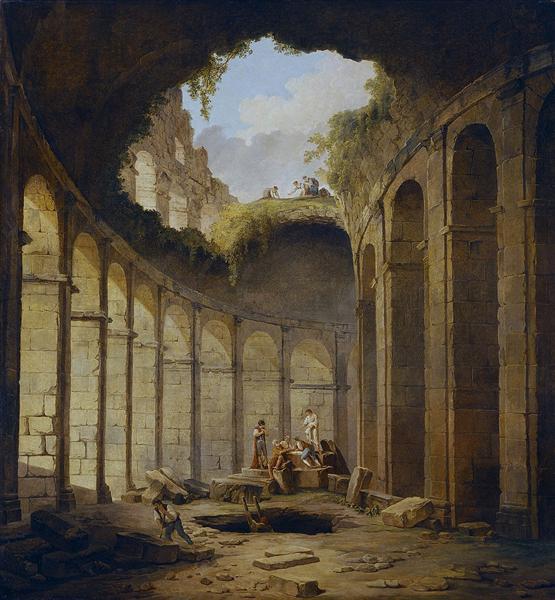Description
Hubert Robert, one of the most prominent painters of the 18th century, offers in his work "Coliseum - Rome - 1790" A captivating and detailed representation of the famous Roman amphitheater. This painting, both for its technical skill and for its historical and emotional evocation, is erected as a testament to Robert's talent and his deep understanding of architectural landscapes.
The composition of this work is masterful, leading the spectator directly to the heart of the Colosseum. The very structure of the amphitheater, with its walls worn by time and nature, is captured with almost documentary precision. Robert manages to capture not only the magnitude of the coliseum, but also the texture of his stones, the effects of erosion and vegetation that begins to claim the monument, suggesting the inexorable passage of time and the transience of human glories.
The use of color in "Colosseum - Rome - 1790" is remarkably sober but effective. Robert uses a palette that varies between the warm earthly tones of the colosseum and the blue -grayish skies, creating a contrast that perfectly frames the central scenario. This chromatic contrast not only highlights the monumentality of the building, but also infuses the scene a melancholy that seems to reflect on the days of yesteryear and the present decadent of the monument.
Analyzing the work, several characters that populate the scene can be observed, imbueting the ruin of an unexpected dose of vitality. Roman, scattered and tiny citizens compared to the vast scale of the coliseum, offer a sense of human scale and an implicit narrative about how these ancient structures interact with people's daily lives. Some seem simple passersby, while others could be exploring the ruins in a kind of contemplation or study, their presence adding a subtle dynamism to the general composition.
In addition, Robert does not omit the thorough details in the architecture itself, where each arch, each shadow and every stone fragment were represented with a meticulous attention to detail. This meticulousness is characteristic of Robert's work, who won the nickname of "Robert de las Ruinas" for his evocative representations of classic buildings in decline. Each work of his is a conversation between the past and the present, and "Colosseum - Rome - 1790" is no exception.
Hubert Robert's work reflects a deep and romantic fascination with the ruins, a recurring theme in the art of the 18th century that resonated with the public of the time. This interest was not only based on an archaeological fervor, but also on a philosophical meditation on history, culture and traces of time. "Coliseum - Rome - 1790" brilliantly encapsulate this duality, offering a window to the ancient world while leaving the viewer in a state of reflection on mortality and memory.
In summary, "Colosseum - Rome - 1790" by Hubert Robert is a work that dialogues with the spectator at multiple levels. Its precise composition, the business use of color and inclusion of human figures give this painting a sense of dynamism and historical relevance. As an austere visual poem, the work invites us to contemplate not only the greatness of Rome, but also the unavoidable march of time and the eternal interaction between man and his creations.
KUADROS ©, a famous paint on your wall.
Hand-made oil painting reproductions, with the quality of professional artists and the distinctive seal of KUADROS ©.
Art reproduction service with satisfaction guarantee. If you are not completely satisfied with the replica of your painting, we refund your money 100%.

